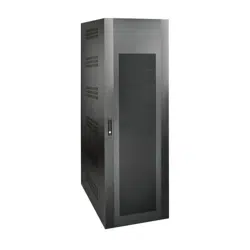Loading ...
Loading ...
Loading ...

6
3. Battery Cabinet Installation
5. Forklift forks should be at maximum width within the cabinet clearance opening and fully inserted to prevent tipping. Lift cabinet from
bottom only. Be careful not to damage the sheet metal floor of the cabinet with the forks.
6. If the battery cabinet will be secured to the floor, carefully align and lower the battery cabinet down on the floor anchor bolts and secure
it in place.
7. If the cabinet will not be secured to the floor, lower it into the designated space and then level it using shims. Leveling does not affect
performance, but does align the battery cabinet with other equipment in the facility.
3.7 Electrical Connection
DANGER! LETHAL HIGH VOLTAGE HAZARD!
All wiring should be performed by a qualified electrician in accordance with the warnings in this manual and all
applicable electrical and safety codes. Incorrect wiring may cause serious personal injury and property damage.
• The battery cabinet is connected to the load through a DC circuit breaker. This allows the battery to disconnect from the load and charger
for maintenance and/or repair.
• The DC molded case circuit breakers are CE approved for branch circuit protection. If replacement is required, CE approved components
with the same voltage and current rating must be used.
• The size of the load connection cables must consider maximum allowable voltage drop as well as the cables’ continuous ampere capacity
and anticipated ampere discharge rate of the individual battery cabinet. A maximum voltage drop of 1.5V DC in the load connection
cables is recommended. Refer to the UPS unit’s Owner’s Manual for recommended wire sizes.
• Refer to all applicable local, state and national codes for appropriate cable size and ratings.
• External circuit protection devices (fuses or circuit breakers) must consider the discharge rate of the battery, the wiring to be protected and
the DC short circuit current of the battery.
After performing the installation procedures in Section 7.:
1. Open the front door of the battery cabinet to access internal components. Use a digital voltmeter when voltage measurements are
required.
2. Determine if the battery has been inadvertently grounded by resetting the circuit breaker to the “On” position and measuring the voltage
between the battery cabinet grounding lug and the positive load connection point within the cabinet. This voltage should measure
0 (zero) VDC. If the measured voltage is not zero, determine the cause and correct before proceeding.
3. Return the internal circuit breaker to an open “Off” position as a safety precaution while connecting the output cables. Doing so prevents
damage in the event the cables are accidentally shorted.
4. The top of the battery cabinet includes knockouts for load connection cable entry. Punch out the appropriate knockout and connect the
conduit or cable bushing.
5. The output circuit breaker accommodates cables up to 300 mm
2
.
6. Connect an appropriate equipment grounding cable to the grounding lug located on the top of the battery cabinet.
7. Feed the positive and negative cables (and “N” center, if equipped) from the open external disconnect switch or the UPS battery field
wiring terminals through the conduit/cable bushing. Connect to the respective output terminals inside the battery cabinet.
3.8 Final Electrical Check
Before closing any connecting circuit breaker or disconnect switch, complete these verification steps:
1. Verify the battery cabinet output voltage is correct.
2. If battery cabinets will be operated in parallel, verify that the individual system output voltages match within 2V DC.
3. Verify the voltage measured between either output terminal and the battery cabinet ground is zero.
4. If any of the above verification steps show an irregularity, determine and correct the cause before proceeding.
5. Reset the circuit breaker to the “On” position.
Loading ...
Loading ...
Loading ...
